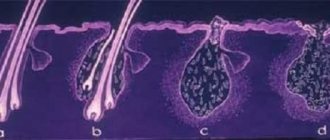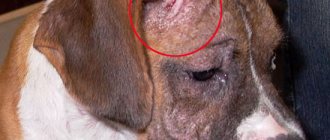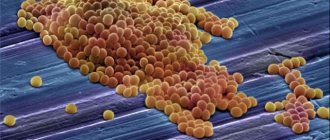Many people know about ixodid ticks that carry piroplasmosis, but only a few know about their closest relatives (microscopic Demodex canis). These tiny parasites, whose length does not exceed 0.3 mm, cause demodicosis in dogs - a dangerous pathology, often complicated by secondary infection. A sick pet may die from exhaustion or sepsis, so it is very important not to lose sight of the first alarming symptoms.
What kind of disease is demodicosis in dogs?
A parasite called Demodex canis lives in dogs' bodies on a permanent basis. It can be found in hair follicles, as well as the sebaceous and sweat glands located next to the hairs.
This endoparasite feeds on keratin, and its larvae feed on dead particles of the epidermis. After destroying the reserves inside one hair, the adult gnaws its way to another, that is, it is constantly in motion.
Despite such a strange cohabitation, discomfort in a four-legged pet appears only when demodex actively multiplies. Due to a sharp drop in immunity, the number of eggs laid and the number of parasites are rapidly increasing. The depth of the tunnels increases as ticks have to look for new food sources. Not only the skin, but also the internal organs are affected.
The vital activity of parasites provokes severe itching and intoxication. As a result of numerous scratches, the likelihood of a secondary infection increases.
Main causes of manifestation
Most of the time, ticks are dormant. Their awakening is associated with a number of unfavorable factors that differ depending on the age of the animal.
In puppies - juvenile
Demodicosis in a puppy is called juvenile. Most often it is transmitted from a sick mother and is accompanied by zonal baldness around the eyes. Activation of the parasite occurs when:
- infection with viruses or bacteria;
- change of baby teeth;
- docking of ears or tail;
- introduction of the first vaccine.
All these situations complicate the independent fight against the pathogen, so children have to be treated with medications. All recovered animals must be sterilized to eliminate the possibility of transmitting the disease to future offspring.
In adults
Pets older than 1 year are more resistant to the pathogen, but they can also get sick. The sudden drop in their immunity is usually to blame for:
- helminthiases and infections (pyoderma, distemper);
- autoimmune disorders (lupus, pemphigus);
- oncology;
- allergies and dermatitis;
- hormonal imbalances (estrus, pregnancy, childbirth);
- surgery and long-term use of certain medications;
- mental disorders and stress;
- poor quality nutrition;
- hypothermia and unsuitable climatic conditions.
Those at risk include Afghan Hounds, Great Danes, Airedale Terriers, Shar-Peis, English Bulldogs, Alaskan Malamutes and Weimaraners. Representatives of these breeds require increased attention, since genetic predisposition has no prevention.
Treatment and prevention for subcutaneous mites
Treatment methods for diseases caused by different types of ticks are similar, but also have a number of significant differences.
In any case, it is necessary to use an integrated approach to treatment.
Isolation of the patient
First of all, you need to protect other animals that can become infected from a sick dog. To do this, it is necessary to isolate the sick animal, if possible excluding contact with it from other tailed household members (this measure is not necessary for demodicosis, which is poorly transmitted).
Use of anti-tick drugs
The causative agent of the disease, the tick, is directly affected by anti-tick (acaricidal) drugs of systemic action.
Such medications are available in various forms: they can be injected, given orally in the form of tablets, applied in the form of drops on the withers (spot-on), applied externally to the skin in the form of a spray or gel.
How to properly apply tick drops to a dog’s withers (video from the manufacturer Bayer)
Systemic drugs also include drugs based on ivermectin and avermectins, which are effective against ticks, but can lead to serious side effects. In addition, collies and related breeds have been found to have a genetic intolerance to such drugs - these dogs are strictly prohibited from using them!
External treatment
Treatment with antiparasitic drugs in the form of solutions for external use (neostomazan, neogard, deltsid, butox, amit) is widely used. The preparations can be applied to the dog's fur by wetting, spraying or bathing the animal (you must be careful in their application, avoiding the solutions getting into the eyes, mouth, nose and ears).
Photo: Red Golden (Co)
Serious skin damage by mites can be accompanied by disruption of the sebaceous glands, leading to seborrhea - increased sebum secretion. In this case, you will need to trim the hair in the affected areas and clean the skin with an antiseborrheic shampoo (tropicline, doctor, global-vet, elite medicinal, etc.).
Fighting allergies
Tick-borne diseases are often accompanied by an allergic reaction of the dog’s body, which can manifest itself as redness of the skin, itching, and swelling. To treat allergies, steroid hormones are prescribed - glucocorticoids (hydrocortisone, prednisolone, dexamethasone, etc.).
These drugs effectively reduce the allergic reaction, however, the use of glucocorticoids is strictly prohibited for demodicosis and concomitant fungal infections due to the negative effect on the dog’s immunity.
Antibiotics and antifungals
Secondary (secondary) infection is a common companion of tick-borne diseases, because inflammation and damage to the skin creates favorable conditions for the development of bacterial and fungal microflora.
To combat it, antibiotics and/or antifungal drugs are prescribed; the choice of a specific drug depends on the results of studies (including determination of antibiotic sensitivity).
Auxiliary medications
Veterinary probiotic Purina fortiflora Canine To protect the gastrointestinal tract, dogs are prescribed drugs that improve liver function (hepatoprotectors) - Carsil, Heptral, Essentiale.
The use of probiotics to maintain normal intestinal microflora is also indicated - Linex, Lactobacterin, Acipol, Purina Fortiflora Canine (veterinary probiotic for dogs).
Vitamin preparations will have a general strengthening effect and will help your pet cope with exhaustion.
Litter treatment
It is important to regularly treat the place where the dog is kept, with frequent changes of bedding. The already mentioned antiparasitic drugs for external use are suitable for treatment.
Contagiousness to animals and people
Demodex causes disease in both animals and humans. The only difference is the type of pathogen. Dog ticks are completely safe for humans, and human ticks are completely safe for dogs. Treatment of a sick pet can be carried out without special protective equipment.
If there are other four-legged animals in the house, be sure to isolate them from the infected person. Transmission of ticks is possible by touching parts of the body: paws, muzzles or ears. During treatment, it is recommended to regularly carry out wet cleaning with disinfectants and treat the sick dog’s personal belongings with acaricidal preparations.
Sarcoptic mange (scabies)
The causative agent of sarcoptic mange, a mite of the genus Sarcoptes, is found both on the surface of the skin and in its thickness.
Peculiarities
Sarcoptic mange is highly contagious and is transmitted through direct contact with a sick animal or through care items (can also be transmitted to humans).
All dogs, without exception, are susceptible to the disease.
Symptoms of sarcoptic mange
In animals infected with sarcoptic mange, redness appears on the skin, scales and crusts form. Partial baldness is possible. Signs of the disease most often appear in the muzzle and elbow joints, but in case of severe damage they can spread throughout the body.
A dog with skin lesions due to sarcoptic mange. Photo: Judithsviews
The vital activity of sarcoptes causes severe itching, which may appear before other clinical signs.
Sarcoptic mange is also characterized by the so-called “ear-foot reflex” - touching the ear of a sick dog causes involuntary movements of the hind paw (an attempt to scratch the ear).
Severe infection of a dog with sarcoptic mange. Photo: Rosario Arredondo
In advanced cases, without timely provision of veterinary care to the dog, the entire skin is damaged, the animal is in a state of severe exhaustion, and a characteristic sour odor emanates from it.
Forms of pathology
Based on the area of damage, the pathology is divided into 2 forms:
- localized, characterized by the presence of no more than 4 lesions with a diameter of up to 2.5 cm;
- generalized, covering most of the body and often acting as a complication of the localized form.
The first form is curable in 90% of cases and very often goes away on its own. The second form is characterized by a more severe course with complications, so it is treated strictly with medication.
Symptoms of demodicosis in dogs with photos
Treatments for demodicosis in dogs depend on the symptoms. The photo clearly shows that the localized form can occur in different ways. It causes either severe dryness of the skin or ulceration.
Scaly
Accompanied by severe itching and redness of the skin. The most commonly affected areas are the ears, neck, eyelids, nose and interdigital spaces. Hairs deprived of keratin lose their strength and begin to fall out. The skin in these areas becomes rough and cracks.
Pustular
It develops independently or as a complication of scaly pathology. It is characterized by the appearance of dense nodules with purulent contents of black or red-brown color. Ripe abscesses burst, spraying foul-smelling exudate over neighboring areas. Spreading pus ulcerates healthy tissue and increases the affected area.
Generalized
Dried pus, mixed with blood and dead epidermis, turns into a scab. At this point, the disease becomes a generalized form, combining scaly and pustular symptoms. Due to the gradual damage to internal organs, the symptoms are complemented by a deterioration in appetite, weakness, vomiting, loss of coordination and convulsions.
Generalized pathology is very difficult to treat and has a poor prognosis. The chances of recovery decrease when a secondary infection occurs. In this case, the animal can be saved only in 50% of cases.
How to recognize
The initial symptoms of invasion are devoid of individual coloring, and in adult and healthy animals they are completely absent. This complicates timely diagnosis, so with any behavioral changes it is better to play it safe and consult a doctor.
What does a subcutaneous mite look like?
Most subcutaneous mites enter the body from the outside and penetrate deep into the skin. These parasites include:
- Notoedres. Dirty gray mites with a rounded body 0.2-0.45 mm long, cone-shaped limbs and a horseshoe-shaped proboscis. They parasitize the outside of the ear and cause notoedrosis.
- Sarcoptes scabiei. Completely white or yellowish-white mites with a broadly oval body 0.14-0.45 mm long, a convex back and numerous scales covering 4 pairs of limbs. They affect the entire surface of the body and cause sarcoptic mange.
An exception is the Demodex canis mite, a parasite that lives in the animal’s body on a permanent basis. Its cigar-shaped body is colored light gray and has a length of 0.2-0.3 mm.
What it looks like on a dog:
Symptoms
The first symptoms appear some time after the bite. Sick pet:
- refuses food and does not react even to favorite treats;
- loses usual activity and falls into a state of apathy;
- shows irritation when attempting contact;
- freezes in any conditions, and his body temperature rises.
Secondary symptoms will help distinguish a tick infestation from a common cold:
- severe itching, forcing the dog to scratch the bite sites into blood;
- redness and cracking of the skin;
- hair loss, leading to baldness in the affected areas;
- the formation of dandruff and suppuration with a putrid odor.
In addition to general symptoms, individual symptoms can be identified, depending on the type of tick :
- Notoedres. In addition to itching and inflammation, dark gray discharge from the ears is added, accompanied by an unpleasant odor.
- Sarcoptes scabiei. Thin lines of light gray color appear on the affected area, ending in a small bubble at the end.
- Demodex canis. Inflammations are point-like in nature, and the disease (demodex) occurs in 2 forms:
- Localized. Up to 5 lesions no more than 2.5 cm in diameter appear on the affected part of the body (muzzle, paws). Young animals 1.5-2 years old are susceptible to this form. It is easy to treat and in some cases goes away on its own.
- Generalized. Appears in the absence of treatment of a localized form and affects most of the body. Does not depend on age and is accompanied by painful itching and purulent inflammation. If a secondary infection occurs, the chances of recovery are reduced to 50%.
The hardest tick infestations are suffered by pets:
- under 2 years old;
- with chronic diseases;
- with a rich pedigree and an ideal exterior.
Possible complications
The vital activity of parasites affects the functionality of the lymph nodes, kidneys, stomach, spleen and liver. Ticks block gaps in the capillaries, depriving internal organs of regular blood flow. Without timely treatment, this can be fatal.
Numerous tunnels gnawed by Demodex are filled with intercellular fluid. A moist and warm environment attracts bacteria, which easily make their way through wounds. Having avoided a collision with immune cells, a secondary infection aggravates the existing condition, provoking the transition of the disease to a generalized form.
Diagnostic methods
To make a diagnosis, the veterinarian must take a medical history and examine the patient. Thanks to the owner's answers, he can find out the cause of the disease even before conducting research.
The symptoms caused by Demodex are similar to other mites, allergies, trichophytosis, microsporia, nutritional dystrophy and some infections. The type of pathogen is determined by scraping.
Scraping
Scraping is the main test for demodicosis in dogs, which is taken from the affected skin. To do this, it is pre-squeezed, provoking the release of parasites from the tunnels closer to the hair roots. Biomaterial is taken from several lesions at once to increase the accuracy of the analysis.
Other tests
In addition to scraping, other studies are also carried out. These include:
- general and biochemical blood and urine tests, revealing intoxication by waste products of parasites;
- bacteriological culture, used in the presence of a secondary infection to determine the type of bacterium and its sensitivity to antibiotics;
- trichoscopy, which determines the condition of the hair follicles;
- Ultrasound and x-rays recording the condition of internal organs.
After determining the cause and form of the disease, the veterinarian draws up an individual treatment plan. The owner must strictly follow all his recommendations. Acaricides are very toxic, so an overdose can lead to very unpleasant consequences.
Signs and symptoms of the disease
Typically, the pathology affects the head area, then moves to the neck and joints of the limbs. In the generalized form, the disease manifests itself in other parts of the body. The following signs are noticeable on the affected part:
- Redness and cracking of the skin, pus.
- Hair loss, bald patches.
- Varying intensity of itching. It may be mild or absent. Therefore, when a pet is sick, it does not always itch, but sometimes licks the affected areas. If there is itching, the dog will scratch almost continuously.
- The smell of rot comes from the pus that flows from the pustules.
- Chills even in hot weather due to impaired thermoregulation.
The damage is small at first, but then grows greatly. Hair loss occurs in areas of inflammation. Infection with subcutaneous mites affects the behavior of the pet. Lethargy, irritability, and a desire for solitude appear. The dog does not want to communicate even with the owner.
How to treat demodicosis in dogs
Treatment of demodicosis in dogs is carried out at home using anti-tick medications. The list of necessary medications is quite extensive, since some of them affect only adults, while others affect larvae. Also, for recovery you will need to take a course of symptomatic medications.
The duration of drug therapy for localized pathology is 1-2 months. In case of generalized disease, the period is determined individually, since the disease very often recurs. Recovery is confirmed upon receipt of 2 negative tests in a row.
Acaricidal injections
Injections are prescribed exclusively for generalized pathology, since external treatment is sufficient to treat localized pathology. The injection solution is administered subcutaneously or intramuscularly every 7-10 days until the parasites completely disappear.
Shampoos
The use of shampoos is necessary to remove dead epidermis, eliminate itching and unpleasant odor. Thanks to preliminary cleansing, acaricidal and healing ointments penetrate into the deeper layers of the skin, which increases their effectiveness.
Acaricidal ointments
For more convenient application of ointments, the hair is cut or shaved. Dried scabs are removed with a cotton pad soaked in chlorhexidine or miramistin. Only after this acaricidal preparations are applied to the affected area. Many of them have antibacterial properties, which is very important in the presence of a secondary infection.
It is recommended to cover ointments that are too greasy with a bandage to prevent licking until completely absorbed. The Elizabethan collar copes with the same task.
Healing ointments
Tissue regeneration is stimulated with levomekol, panthenol and ichthyol ointment. They reduce irritation, preventing the appearance of new scratches. These drugs are applied directly on top of the previous ones 5-7 times a day.
Drops
In addition to ointments, it is necessary to use antiparasitic drops. They cope very well with single lesions. Please note that the applied layer must be renewed after each wash, and long-haired pets will require a larger dosage.
Pills
Another possible form of antiparasitic drug is tablet form. The effect of using tablets is similar to injection, but occurs a little later. This method of treatment is suitable for shy pets who are very afraid of injections. To kill ticks, it is enough to use the drug once every 4 weeks for 3 months.
Folk remedies
As an additional therapy, the use of folk remedies is acceptable. Most often used:
- tar soap;
- oatmeal baths;
- sea buckthorn oil;
- lotions made from grated apples and juniper berries;
- decoctions of wormwood and celandine.
Please note that herbs often cause allergies. Before applying the product, be sure to test it on a small area of skin.
Other drugs
Other drugs include immunomodulators and vitamin supplements that help boost immunity. The dog is also prescribed probiotics and hepatoprotectors, which restore the intestinal microflora and liver after taking antibiotics and intoxication with parasites.
Prevention
The risk of infection by ticks cannot be completely eliminated, but by following basic rules of care and maintenance it can be minimized.
For the health of your four-legged friend it is important:
- Increase the dosage of acaricidal drugs if you have long hair. This rule also applies to frequent bathing, which washes off the applied drug from the skin.
- Monitor the quality of food. Avoid mixing dry and natural feeding, and avoid purchasing cheap food and low-quality products. Remember that if the dog eats natural food, then it must be given vitamins agreed upon with the veterinarian.
- Refuse planned mating if parasites are detected. Each participant must undergo a comprehensive check, so request confirmation certificates from the second owner.
- Limit communication with unfamiliar animals. Stray and wild animals, which are carriers of dangerous infectious diseases, pose a particular danger.
- Carefully inspect the skin and coat after each walk. Parasites like to get into hard-to-reach places, so check the tail, ears, armpits, groin area and limbs.
- Sterilize him after an illness. Subcutaneous mites are dangerous due to hormonal imbalances that can cause relapse, and congenital diseases in the offspring.
- Seek help from a veterinary clinic if you have any alarming symptoms. It is better to make a mistake in self-diagnosis than to fail to prevent a real disease at an early stage.
Additional protection against parasites will be provided by special antiparasitic drugs:
- Collars (Kiltix, Beafar, Foresto). Collars are effective for 6 months, but are often accompanied by allergies and are not suitable for:
- lactating and pregnant animals;
- puppies under 2 months;
- dogs with low immunity and chronic diseases.
- increase the amount of product for animals with long hair by approximately 2 times;
On the topic: vaccinations for puppies by age.
Features of nutrition during the treatment period
The vital activity of ticks is accompanied by the active production of toxins that disrupt the process of food digestion. To restore the functions of the gastrointestinal tract, the patient is put on a gentle diet. It provides:
- Elimination of fatty and heavy foods. The main emphasis is on chicken breast, beef tenderloin and oatmeal.
- Refusal to reheat. Don't cook several days ahead. Food should not only be of high quality, but always fresh. It is also worth monitoring her temperature. When served, it should correspond to room temperature.
- Transition to fractional meals. Reduce the single portion, increasing the number of feedings to 4-5 per day.
- Monitoring adequate fluid intake. Change the water in the bowl regularly and include rosehip infusions in your daily menu.
When feeding dry kibble, it is recommended to switch to a special line for allergy sufferers. It can be found from manufacturers that produce products of at least premium class.











